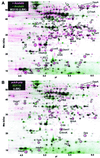Acetate and formate stress: opposite responses in the proteome of Escherichia coli
- PMID: 11591692
- PMCID: PMC100143
- DOI: 10.1128/JB.183.21.6466-6477.2001
Acetate and formate stress: opposite responses in the proteome of Escherichia coli
Abstract
Acetate and formate are major fermentation products of Escherichia coli. Below pH 7, the balance shifts to lactate; an oversupply of acetate or formate retards growth. E. coli W3110 was grown with aeration in potassium-modified Luria broth buffered at pH 6.7 in the presence or absence of added acetate or formate, and the protein profiles were compared by two-dimensional sodium dodecyl sulfate-polyacrylamide gel electrophoresis. Acetate increased the steady-state expression levels of 37 proteins, including periplasmic transporters for amino acids and peptides (ArtI, FliY, OppA, and ProX), metabolic enzymes (YfiD and GatY), the RpoS growth phase regulon, and the autoinducer synthesis protein LuxS. Acetate repressed 17 proteins, among them phosphotransferase (Pta). An ackA-pta deletion, which nearly eliminates interconversion between acetate and acetyl-coenzyme A (acetyl-CoA), led to elevated basal levels of 16 of the acetate-inducible proteins, including the RpoS regulon. Consistent with RpoS activation, the ackA-pta strain also showed constitutive extreme-acid resistance. Formate, however, repressed 10 of the acetate-inducible proteins, including the RpoS regulon. Ten of the proteins with elevated basal levels in the ackA-pta strain were repressed by growth of the mutant with formate; thus, the formate response took precedence over the loss of the ackA-pta pathway. The similar effects of exogenous acetate and the ackA-pta deletion, and the opposite effect of formate, could have several causes; one possibility is that the excess buildup of acetyl-CoA upregulates stress proteins but excess formate depletes acetyl-CoA and downregulates these proteins.
Figures




References
-
- Almirón M, Link A J, Furlong D, Kolter R. A novel DNA-binding protein with regulatory and protective roles in starved Escherichia coli. Genes Dev. 1992;6:2646–2654. - PubMed
-
- Altuvia S, Almiron M, Huisman G, Kolter R, Storz G. The dps promoter is activated by OxyR during growth and by IHF and ςs in stationary phase. Mol Microbiol. 1994;13:265–272. - PubMed
-
- Amarasingham C R, Davis B D. Regulation of α-ketoglutarate dehydrogenase formation in Escherichia coli. J Biol Chem. 1965;240:3664–3668. - PubMed
Publication types
MeSH terms
Substances
LinkOut - more resources
Full Text Sources
Other Literature Sources
Molecular Biology Databases

